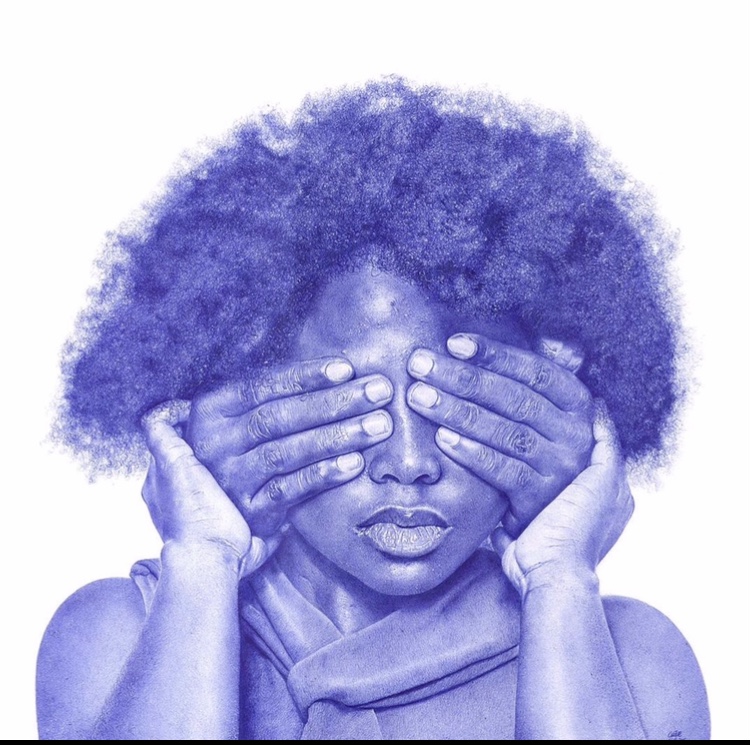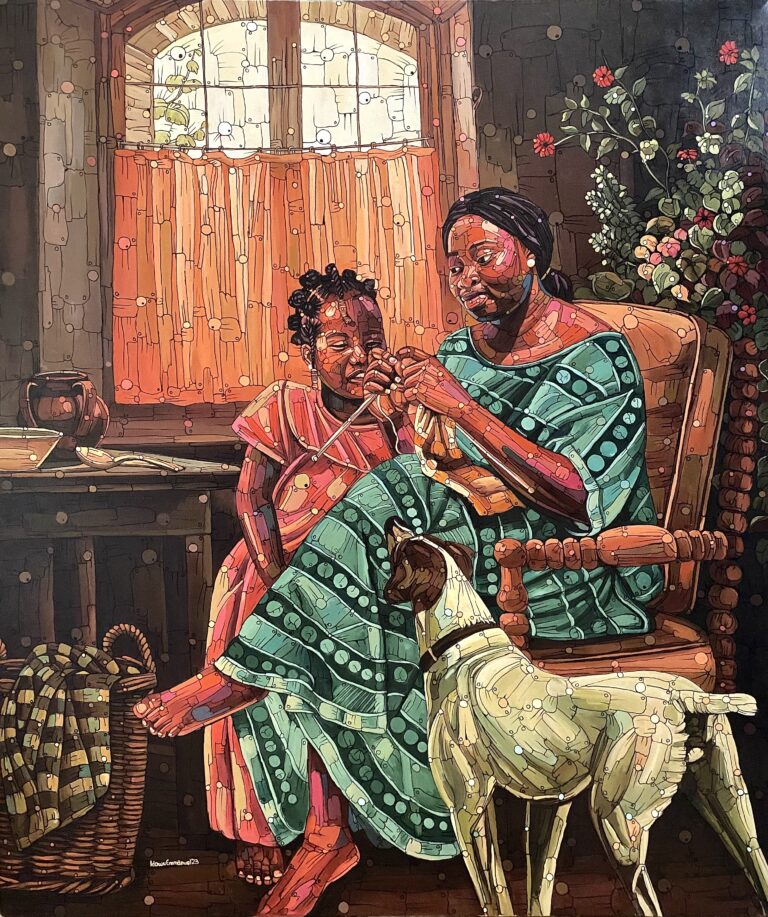The Absa L’Atelier art competition is a leading Pan-African art competition. The competition, which has been running for 37 years this year, is hosted annually by Absa in partnership with the South African National Association for the Visual Arts (SANAVA).
We speak to this year’s winners.
Edward Lawerh (Group A, Ghana)
Edward Lawerh is a Ghanian contemporary artist born in Ada in the greater Accra region. He is a Bachelor of Fine Art Painting and Sculpture graduate at the Kwame Nkrumah University of Science and Technology Kumasi, Ghana. His works take the form of painting in a distorted and tattoo-like form, looking at the negative impact of chemicals on humans generally in various spaces. He is a member of Blaxtarlines, the Department of Painting and Sculpture KNUST.

Edward Lawerh, Kweku the Traveller. Oil paint, collages and agro Chemicals on Jean cloth, 30 x 30cm. Courtesy of the artist and Absa.
Being chosen as an Absa L’Atelier ambassador is a significant achievement. Could you share what this honour means to you and provide some insights into the responsibilities and commitments that come with it?
It is an honour to be named Absa L’Atelier ambassador 2023; it is a great testament to the value and importance of my work. However, I am taking on this ambassadorship, and I am looking forward to having a major impact on my artistic journey in the years to come. The multidisciplinary nature of this role, involving interaction with diverse perspectives and working with fellow Ambassadors, would probably bring significant change in my artistic practice. The Ambassadorship’s platform offers me an avenue to showcase my work and facilitates networking and exposure, potentially leading to unique projects and opportunities. The Ambassadors position is a powerful force that will shape and improve my artistic practices in the foreseeable future. I am grateful for the opportunity to amplify my voice and to be part of the ongoing dialogue in the art world.
Could you elaborate on the artworks that earned you the winning recognition?
The works that won me recognition are part of my professional artistic practice, where I use mixed media techniques to execute each work. I use pesticide solutions and the labels, oil paints, acrylic paints, collages, and image transfer on canvas.
In my community, farming is one thing no one takes for granted; this is the livelihood of many, of which I am a part. My life, education, and survival largely depend on this work.
Being part of the farming community all my life, one constant thing among small-scale farmers such as ours is the ignorance of the dangers associated with the chemicals we use on our farms, especially among the less educated. These pesticides are hazardous to the skin and our environment; we are constantly exposed to these harmful substances, which are now part of us. Going to university, I realised the need to educate the public through a universal language.
Inspired by Magdalena Abakanowicz’s quote, “Art does not solve problems but makes us aware of their existence. It opens our eyes to see and our brains to imagine.” I create art that informs and educates.
Art is not merely a means of expression; it’s a tool for societal dialogue and transformation. These are what inspired me to create the award-winning works.
What kind of inspiration do you believe your award-winning work can provide to fellow artists?
My award-winning works have the potential to serve as a catalyst for fellow artists, encouraging them to broaden their horizons beyond conventional mediums in painting. Exploring and challenging traditional artistic norms can lead to a redefinition of painting techniques. Without innovative exploration and development of concepts and skills, the prominence of traditional art’s propositions may dwindle or be reduced or diminished.
In addition, my works are likely to inspire fellow artists to be receptive to allowing themselves to be influenced by what they are engaged in as individuals in their respective locations. This openness to external stimuli can contribute to the infusion of fresh ideas into their artistic endeavours. The synthesis of diverse influences can enrich their work and contribute to the evolution of their creative expression.
How do you anticipate this ambassadorship will influence your artistic journey in the years to come?
Having received the Absa L’Atelier ambassadorship is significant; this will impact my artistic journey in the years ahead. The ambassadorship would help me to engage with diverse perspectives, collaborate with other ambassadors, and have a platform to showcase my work and facilitate networking exposure, potentially leading to unique projects and opportunities. I anticipate a broader artistic evolution and increased opportunities for creativity and growth.
Gayi Eric Joe (Group B, Uganda)
Gayi Eric Joe is a visual artist inspired by hyperrealism and surrealism, with his artworks having elements of juxtaposition and visual puns. His drawings tell his personal stories and the emotional insecurities of people around him. He constantly explores and expresses black identity, affairs and pride in surreal and hyperrealistic ways. His best medium is a ballpoint pen on paper; it gives him more control over his drawings and enables him to express his emotions and mind throughout the drawings, which takes me approximately 200 to 500 hours to finish a decently sized art piece.

Gayi Eric Joe, Into your hands I. Ballpoint pen on white paper on ivory board, 51 x 49cm. Courtesy of the artist and Absa.
Being chosen as an Absa L’Atelier ambassador is a significant achievement. Could you share what this honour means to you and provide some insights into the responsibilities and commitments that come with it?
Being chosen as an Absa L’Atellier ambassador is indeed a significant honour for an artist. It typically carries several important implications:
Recognition and Prestige signify that my work has been acknowledged and celebrated on a larger platform, which can boost my reputation and standing in the art community. As an ambassador, I gain greater local and potentially international visibility, which can open doors to new opportunities and a broader audience for my art.
Regarding my responsibilities, Ambassadors are expected to represent the values and mission of the Absa L’Atellier program, including participating in promotional events, workshops, or exhibitions. Artistic community engagement, mentorship and advocacy.
Being an Absa L’Atellier ambassador is a testament to an artist’s talent and commitment to giving back to the artistic community and fostering the growth and development of Art and artists.
Could you elaborate on the artworks that earned you the winning recognition?
The first drawing has hands wrapped around the face of a female model, and the second has hands wrapped around the body of a male model.
As an artist, I wanted to communicate and show how vulnerable we can all be when found in the wrong hands or by vehement people of a higher power, regardless of gender and background.
That thinking has constantly challenged me as an artist; through my pieces ‘Into Your Hands, I and II wanted to show my perspective from both sides of gender and thinking.
What kind of inspiration do you believe your award-winning work can provide to fellow artists?
My artwork can inspire others to embrace their vulnerabilities and acknowledge that it’s a natural part of the human experience. It can encourage self-acceptance and authenticity. It may resonate with individuals who may be prone to vulnerability, making them feel seen and understood. This validation can be a source of comfort and empowerment.
Another’s technique and style may inspire fellow artists and the depth of emotion conveyed in my work. It can motivate them to explore their artistic expression. It also encourages others to express their feelings and experiences creatively through visual arts, writing, or other forms of creative expression.
My award-winning work can provide inspiration and a catalyst for conversations and self-expression, particularly around the themes of vulnerability and proneness, which are deeply relatable to the human condition.
How do you anticipate this ambassadorship will influence your artistic journey in the years to come?
This ambassadorship is likely to increase my visibility in the art world. It could attract more attention to my work, potentially leading to more opportunities, exhibitions, and collaborations with other ambassadors, introducing me to new artistic influences.
The responsibilities and experiences tied to this role can contribute to my artistic growth. It may inspire fresh ideas and approaches to my Art. Additionally, it involves mentoring and advocating for emerging artists, and this could be a rewarding experience and influence my approach to art to guide and support others.
Ultimately, the ambassadorship will likely be a transformative experience for my artistic journey, opening doors to new opportunities and challenges that will shape my future work and creative legacy.
Idowu Emmanuel (Group C, Nigeria)
Idowu Emmanuel was born in Osun State, Nigeria. His passion for art became evident during his secondary school days in Ondo State, and he experienced a breakthrough in his artistic journey during his university studies at OAU Ile-Ife, where he specialised in painting. During this time, he was influenced by books on Pointillism and, colour separation and harmony in painting. This exposure allowed him to experiment with a stylistic approach that involved blending small strokes of colour, ultimately leading him to master the art of visually blending colours together. Emmanuel’s artistic style draws inspiration from African folkloric tradition, ageless wisdom, Yoruba history, spirituality, and cultural heritage. His works reflect a deep appreciation for African culture’s rich artistic traditions and storytelling techniques. Through his art, he strives to capture the essence of his subjects and convey their significance within the broader context of African heritage. His dedication to exploring and incorporating these influences has resulted in a unique and captivating artistic style.

Idowu Emmanuel, Crochet Making. Acrylic on Canvas Size, 127 x 107cm. Courtesy of the artist and Absa.
Being chosen as an Absa L’Atelier ambassador is a significant achievement. Could you share what this honour means to you and provide some insights into the responsibilities and commitments that come with it?
Receiving the honour as an Absa L’Atelier Ambassador 2023 is truly significant; this is a powerful acknowledgement of the value and impact of my work. However, taking on this Absa L’Atelier ambassadorship again, I am poised to exert a profound influence on the trajectory of my artistic journey in the foreseeable future. The multifaceted nature of the role, involving interaction with diverse perspectives and collaboration with fellow ambassadors, is expected to catalyse a substantive evolution in my artistic journey. The ambassadorship’s platform offers an avenue to showcase my work and facilitates networking and exposure, potentially leading to unique projects and opportunities. The ambassadorship is pivotal in shaping and enhancing my artistic endeavours over the coming years. I am grateful for the chance to amplify the voice of my creativity and contribute to the ongoing dialogue within the art world.
Could you elaborate on the artworks that earned you the winning recognition?
The works that won me recognition are part of my professional artistic practices. I used mixed media techniques to execute each, including pesticide solutions and labels on canvas, oil paints, acrylic paints, collages, and image transfer on canvas.
In my community, farming is one thing no one takes for granted; this is the livelihood of many, of which I am a part. My life experience, education, and survival largely depend on this work.
Being part of the farming community all my life, I have observed one constant among small-scale farmers such as us: ignorance of the dangers associated with the chemicals we use on our farms, especially the less educated. These pesticides are hazardous to the skin and our environment, yet we are constantly exposed to these harmful substances, and it looks as if they are now part of us. Getting to university, I realised the need to educate the public through a universal language.
Inspired by Magdalena Abakanowicz’s quote, art does not solve problems but makes us aware of their existence. It opens our eyes to see and our minds to imagine. I create art that informs and educates.
Art is not merely a means of expression; it’s a tool for societal dialogue and transformation. These are what inspired me to create the award-winning works.
What kind of inspiration do you believe your award-winning work can provide to fellow artists?
My award-winning works have the potential to serve as a catalyst for fellow artists, encouraging them to broaden their horizons beyond conventional mediums in painting. Exploring and challenging traditional artistic norms can lead to a redefinition of painting techniques. With innovative exploration and development of concepts and skills, the prominence of conventional art propositions may grow and be maintained.
In addition, my works could inspire fellow artists to be receptive to allowing themselves to be influenced by what they are engaged in as individuals in their respective geographical locations. This openness to external stimuli can contribute to the infusion of fresh ideas into their artistic endeavours. The synthesis of diverse influences can enrich their work and contribute to the evolution of their creative expression and others.
How do you anticipate this ambassadorship will influence your artistic journey in the years to come?
Having received the Absa L’Atelier ambassadorship is immensely significant, and it will significantly impact my artistic journey in the years ahead. This ambassadorship would help me to engage with diverse perspectives, collaborate with other ambassadors, and have a platform to showcase my work and facilitate networking exposure, potentially leading to unique projects and opportunities. I anticipate a broader artistic evolution and increased opportunities for creativity and growth.
Bulumko Mbete (Gerard Sekoto Winner, South Africa)
Bulumko Mbete, born in 1995, is a Johannesburg-based artist and creative practitioner with a multicultural heritage. Mbete completed her BFA at the Michaelis School of Fine Art. She undertakes research in different forms of craft design making. Women in Southern Africa predominantly perform these methodologies. Bulumko is interested in materiality. Through using textile, beading, natural dyeing and weaving, she creates a framework to communicate generational traditions and gestures of love. Mbete’s interests expand into engaging with the archive and using the archive for creative storytelling. In this pursuit, she uses archival matter such as photographs, textiles, and clothes. She explores the geographic connections and synchronicities within her family in relation to South African history and its effect on migration, labour, farming and love.

Bulumko Mbete, Route. Blanket, dyed canvas, beads and twine, 100 x 70cm. Courtesy of the artist and Absa.
Being chosen as an Absa L’Atelier Gerard Sekoto winner is a significant achievement. Could you share what this honour means to you and provide some insights into the responsibilities and commitments that come with it?
Gerard Sekoto is one of the first black fine artists whose practice I came into contact with growing up. His legacy and practice are iconic. Reflecting on his career and how he encapsulated lived realities at the moments he was making will always be powerful; when I think of his work, the idea of memory and representation echo.
This award provides an important opportunity to expand my practice and how people interact with my work. Most importantly, it will be a learning experience for me. I’m invested in making meaning of the world in collaboration with others, and winning the award allows greater freedom and intentionality to do that within my practice. I can achieve this by interacting with other artists and makers, working with various teams across cultural production, and interfacing with a broader public audience.
My responsibilities and commitments are to create socially and culturally relevant work that is generative and not harmful.
Could you elaborate on the artworks that earned you the winning recognition?
The artworks come from a body of work titled ‘Does a Kite Leave a Trace?’. The works were reflections and meditations tracing histories and migration in my family. I am interested in exploring transitions and points of confluence through time. I traced my migration patterns, those of my mother and my paternal grandmother, in part. Because my work looks at material histories and people’s lives alongside objects, I’ve been moving towards abstraction to generate a visual language.
The accompanying text reads as follows:
Does a kite leave a trace?
What gets left behind?
What leaves a memory?
How does that memory transform?
How will I reconfigure memory?
Is it a memory anyway?
Reconstructing three memories of migration.
Tracing love, tracing work. tracing play.
Three generations become one.
Three intersecting stories.
A mother, a daughter, a paternal grandmother.
All these layers are separate and interlaced.
A making process that connects with history, land and women’s labour.
Making up gestures of love, making up a memory of time and place.
What kind of inspiration do you believe your award-winning work can provide to fellow artists?
Big question. I hope it inspires people to reflect on the everyday and the sentimental as a place of wonder and storytelling so that people can see the important ways we create meaning together and that speaking about these experiences builds our understanding of ourselves and masked histories.
How do you anticipate this ambassadorship will influence your artistic journey in the years to come?
It will impact the opportunity to make meaningful connections with people. I know there will be space for collaboration, learning and growing my network. I’m excited to be part of all the twists and turns that come with the journey.
For more information, please visit Absa L’Atelier.



